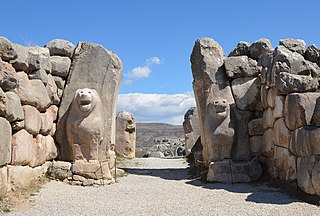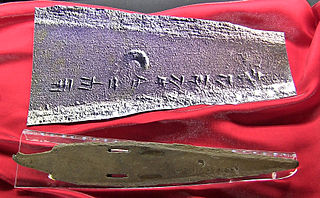Zalpa (also called Zalba, Zalpah, Zalpuwa) were ancient regions mentioned in Assyrian, Mari and Hittite records. The toponyms appear in a variety of forms and contexts and likely refer to multiple similarly named regions. They have been located on the Pontic coast of the Black Sea, along the Euphrates in northern Mesopotamia and along the Balikh river in northern Syria.
The etymology is uncertain but the toponyms may have been Sumerian formulaic theophoric names derived from KA.ZAL. [1] [2] The same syllabary is found in the Akkadian toponym ka-zal-luki in records of the twenty-second through sixteenth centuries BC, [3] [4] [5] [6] which could explain the presence of multiple forms and uses of the toponyms in the historical record. [7]
Zalpuwa is the setting for an ancient legend about the Queen of Kanesh, which was either composed in or translated into the Hittite language: [8]
"[The Queen] of Kanesh once bore thirty sons in a single year. She said: 'What a horde is this which I have born[e]!' She caulked(?) baskets with fat, put her sons in them, and launched them in the river. The river carried them down to the sea at the land of Zalpuwa. Then the gods took them up out of the sea and reared them. When some years had passed, the queen again gave birth, this time to thirty daughters. This time she herself reared them."
The river at Kanesh (Sarımsaklı Çayı) drains into the Black Sea, which seemingly supported the argument that the city was located near the Black Sea.
"Zalpuwa" is further mentioned alongside Nerik in Arnuwanda I's prayer. Nerik was a Hattic language speaking city which had fallen to the Kaskians by Arnuwanda's time. This portion of the prayer also mentioned Kammama, which was Kaskian as of the reign of Arnuwanda II. The conclusion until recently, was to locate Zalpuwa in a region of Hattian cities of northern central Anatolia: as were Nerik, Hattusa, and probably Sapinuwa, and Zalpuwa was thought to have been founded by Hattians, like its neighbours.
Around the 18th century BC, Uḫna the king of Zalpuwa invaded Neša, after which the Zalpuwans carried off the city's "Sius" idol. Under Huzziya's reign, the king of Neša, Anitta, invaded Zalpuwa. Anitta took Huzziya captive, and recovered the Sius idol for Neša. Soon after that, Zalpuwa seems to have become culturally and linguistically Hittite.
Arnuwanda's prayer implies that Zalpuwa was laid waste by Kaskians, at the same time that Nerik fell to them, in the early 14th century BC.
İkiztepe on the Kızılırmak Delta near the Black Sea coast was suggested as a possible location for Zalpuwa. [9]
In 1990, J. M. Córdoba identified Zalpa with Tell Hammam et-Turkman, on the Balikh river, and this proposal was commented as possible by French scholars Nele Ziegler and Anne-Isabelle Langlois in 2016, [10] [11] as well as Eva von Dassow in her (2022) essay. [12]
The city of Zalpa was formerly equated by scholars with Zalpuwa in Anatolia, located to the north of Ḫattuša near the Black Sea. But the Zalpa mentioned in the Annals of Hattusili I has now been proposed as being at the site of Tilmen Höyük, in the Karasu River Valley south of the Taurus Mountains, which had a palace and temple that were violently destroyed near the end of the Middle Bronze Age II. This North Syrian Zalpa was called Zalwar in Old Babylonian texts. The military exploits of Hattusili I, a Hittite king who reigned in the latter part of the seventeenth century BC, are described both in Hittite and Akkadian in clay tablets, now in the Catalogue of Hittite Texts, excavated in Hattusa, the Hittite capital, and mention that he destroyed the city of Zalpa (written Za-al-pa in Hittite and Za-al-ba-ar in Akkadian). [13]

The Hittites were an Anatolian Indo-European people who formed one of the first major civilizations of Bronze Age West Asia. Possibly originating from beyond the Black Sea, they settled in modern-day Turkey in the early 2nd millennium BC. The Hittites formed a series of polities in north-central Anatolia, including the kingdom of Kussara, the Kanesh or Nesha kingdom, and an empire centered on Hattusa. Known in modern times as the Hittite Empire, it reached its peak during the mid-14th century BC under Šuppiluliuma I, when it encompassed most of Anatolia and parts of the northern Levant and Upper Mesopotamia, bordering the rival empires of the Hurri-Mitanni and Assyrians.

Kültepe, also known under its ancient name Kaneš or Neša (Nesha), is an archaeological site in Kayseri Province, Turkey. It was already a major settlement at the beginning of the 3rd millennium BC, but it is world-renowned for its significance at the beginning of the 2nd millennium BC. The archaeological site consists of a large mound, and a lower city, where a kārum was established in the beginning of the 2nd Millenium BC. So far, 23,500 cuneiform tablets recovered from private houses constitute the largest collection of private texts in the ancient Near East. In 2014, the archaeological site was inscribed in the Tentative list of World Heritage Sites in Turkey.

The Hattians were an ancient Bronze Age people that inhabited the land of Hatti, in central Anatolia. They spoke a distinctive Hattian language, which was neither Semitic nor Indo-European. Hattians are attested by archeological records from the Early Bronze Age and by historical references in later Hittite and other sources. Their main centre was the city of Hattush. Faced with Hittite expansion, Hattians were gradually absorbed into the new political and social order, imposed by the Hittites, who were one of the Indo-European-speaking Anatolian peoples. The Hittites kept the country name unchanged, which also became the main designation for the Hittite state.

Hattusa, also Hattuşa, Ḫattuša, Hattusas, or Hattusha, was the capital of the Hittite Empire in the late Bronze Age during two distinct periods. Its ruins lie near modern Boğazkale, Turkey, within the great loop of the Kızılırmak River.

Hattusili III was king of the Hittite empire c. 1275–1245 BC or 1267–1237 BC.

Hattusili I was a king of the Hittite Old Kingdom. He reigned ca. 1650–1620 BC, or ca. 1640–1610 BC.
Ḫalmašuit was a goddess worshiped by Hattians and Hittites in Bronze Age Anatolia. She was the divine representation of a ceremonial throne, and acted as both an embodiment of royal authority and as a protective deity of kings.

Anitta, son of Pitḫana, reigned ca. 1740–1725 BC, and was a king of Kuššara, a city that has yet to be identified. He is the earliest known ruler to compose a text in the Hittite language.
The Anatolians were a group of Indo-European peoples who inhabited Anatolia as early as the 3rd millennium BC. Identified by their use of the now-extinct Anatolian languages, they were one of the oldest collective Indo-European ethno-linguistic groups and also one of the most archaic, as they were among the first peoples to separate from the Proto-Indo-Europeans, who gave origin to the individual Indo-European peoples.

Hittite mythology and Hittite religion were the religious beliefs and practices of the Hittites, who created an empire centered in what is now Turkey from c. 1600–1180 BC.

Kussara (Kuššar) was a Middle Bronze Age kingdom in Anatolia. The kingdom, though apparently important at one time, is mostly remembered today as the origin of the dynasty that would form the Old Hittite Kingdom.
The Kaska were a loosely affiliated Bronze Age non-Indo-European tribal people, who spoke the unclassified Kaskian language and lived in mountainous East Pontic Anatolia, known from Hittite sources. They lived in the mountainous region between the core Hittite region in eastern Anatolia and the Black Sea, and are cited as the reason that the later Hittite Empire never extended northward to that area. They are sometimes identified with the Caucones known from Greek records.

Sapinuwa was a Bronze Age Hittite city at the location of modern Ortaköy in the province Çorum in Turkey about 70 kilometers east of the Hittite capital of Hattusa. It was one of the major Hittite religious and administrative centres, a military base and an occasional residence of several Hittite kings. The palace at Sapinuwa is discussed in several texts from Hattusa.

Nerik was a Bronze Age settlement to the north of the Hittite capitals Hattusa and Sapinuwa, probably in the Pontic region. Since 2005–2009, the site of Nerik has been identified as Oymaağaç Höyük, on the eastern side of the Kızılırmak River, 7 km (4.3 mi) northwest of Vezirköprü.
Purushanda was an Anatolian kingdom of the early second millennium prior to the common era. It was conquered by the Hittites circa 1700 BC. The name disappears from history soon thereafter.

Pala was an ancient region of Anatolia to the northwest of Hattusa at the time the Hittites took control of the land of Hatti. Its inhabitants spoke an Indo-European language called palaumnili and appear to have coexisted with the Hattians for centuries prior. They are lost to history with the advance of Kaskian peoples from the east in the early 1500s BC.
Tell Hammam et-Turkman is an ancient Near Eastern tell site located in the Balikh River valley in Raqqa Governorate, northern Syria, not far from the Tell Sabi Abyad site and around 80 km north of the city of Raqqa. The Tell is located on the left bank of the Balikh and has a diameter of 500 m and is 45 m high. 500 m north is the modern village of Damešliyye.
Ḫalki was the Hittite deity of grain. While it is commonly assumed the name consistently referred to a goddess, a male form of this deity has also been identified. Ḫalki was associated with other grain deities, namely Mesopotamian Nisaba and Hattian Kait, with the latter presumed to be functionally identical. The oldest attestations come from Kanesh, though they are limited to theophoric names. In later periods, the female form of Ḫalki was worshiped in Hattusa, and the male one in Nerik, though evidence from other cities is also available.
Wurunkatte or Wurukatte was a Hittite war god of Hattian origin. He might have also been connected to the institution of kingship. His symbol was a mace, and based on textual sources it is presumed he could be depicted standing on the back of a lion. Inhe appears in association with deities such as Šulinkatte, Taru and Telipinu. He was worshiped in Hattusa, Nerik, Tuḫumijara and Tarammeka.
Ammamma was the name of multiple Hattian and Hittite goddesses worshiped in central and northern Anatolia in the Bronze Age. The best attested Ammamma served as the tutelary goddess of Taḫurpa near Hattusa, and appears in multiple treaties between Hittite kings and foreign rulers.